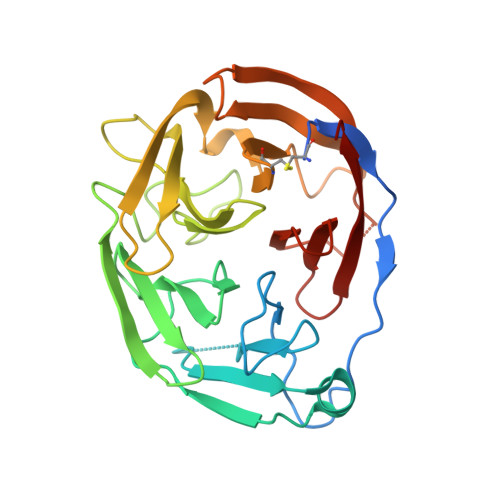Calcium-ligand variants of the myocilin olfactomedin propeller selected from invertebrate phyla reveal cross-talk with N-terminal blade and surface helices.
Hill, S.E., Cho, H., Raut, P., Lieberman, R.L.(2019) Acta Crystallogr D Struct Biol 75: 817-824
- PubMed: 31478904
- DOI: https://doi.org/10.1107/S205979831901074X
- Primary Citation of Related Structures:
6PKD, 6PKE, 6PKF - PubMed Abstract:
Olfactomedins are a family of modular proteins found in multicellular organisms that all contain five-bladed β-propeller olfactomedin (OLF) domains. In support of differential functions for the OLF propeller, the available crystal structures reveal that only some OLF domains harbor an internal calcium-binding site with ligands derived from a triad of residues. For the myocilin OLF domain (myoc-OLF), ablation of the ion-binding site (triad Asp, Asn, Asp) by altering the coordinating residues affects the stability and overall structure, in one case leading to misfolding and glaucoma. Bioinformatics analysis reveals a variety of triads with possible ion-binding characteristics lurking in OLF domains in invertebrate chordates such as Arthropoda (Asp-Glu-Ser), Nematoda (Asp-Asp-His) and Echinodermata (Asp-Glu-Lys). To test ion binding and to extend the observed connection between ion binding and distal structural rearrangements, consensus triads from these phyla were installed in the myoc-OLF. All three protein variants exhibit wild-type-like or better stability, but their calcium-binding properties differ, concomitant with new structural deviations from wild-type myoc-OLF. Taken together, the results indicate that calcium binding is not intrinsically destabilizing to myoc-OLF or required to observe a well ordered side helix, and that ion binding is a differential feature that may underlie the largely elusive biological function of OLF propellers.
- School of Chemistry and Biochemistry, Georgia Institute of Technology, 901 Atlantic Drive NW, Atlanta, GA 30332-0400, USA.
Organizational Affiliation:















